Ernst vs Encana’s lead lawyer, Murray Klippenstein, quit the lawsuit without warning because of the Law Society of Ontario’s Statement of Principles (SOP).
Ernst is horrified she lost her legal representation because of racism.
Cartoon below Rob Rogers:
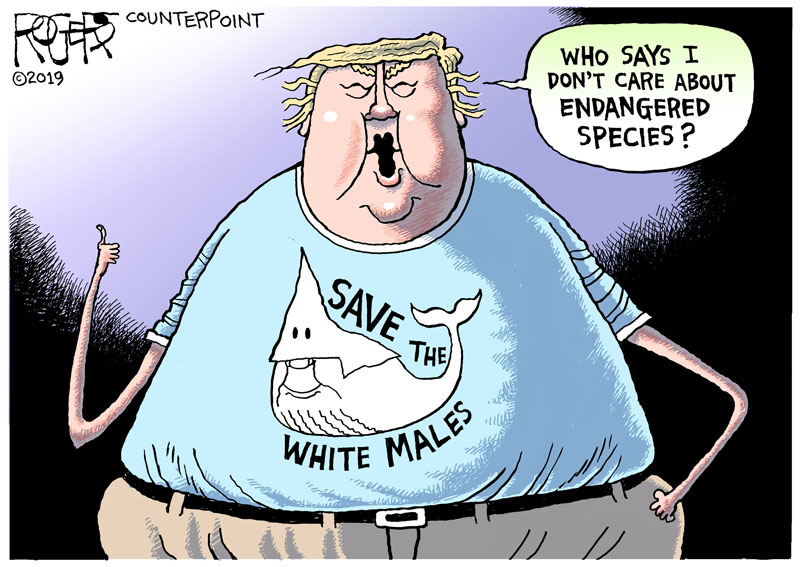
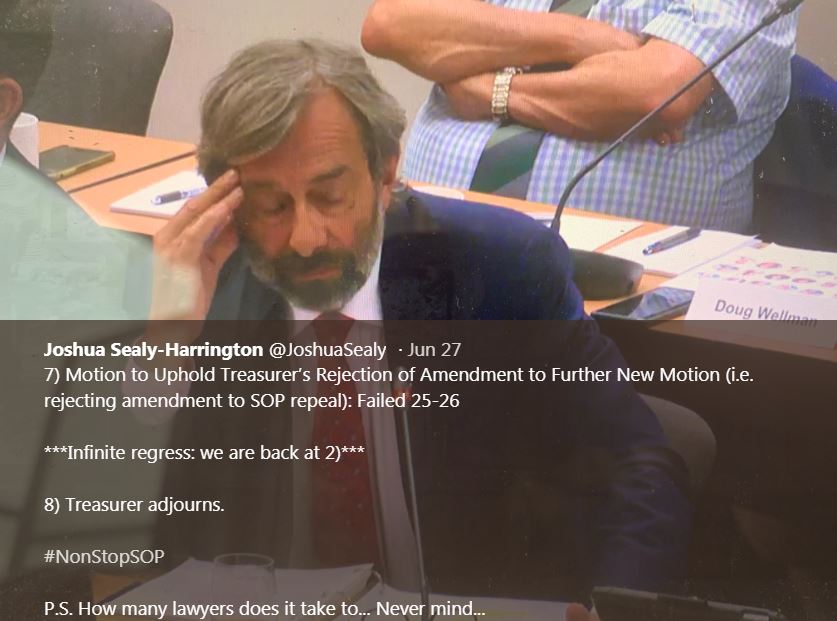
Ernst supports SOP and demands inclusion, risking white power pissing even more on her lawsuit (it’s been pissed on plenty).
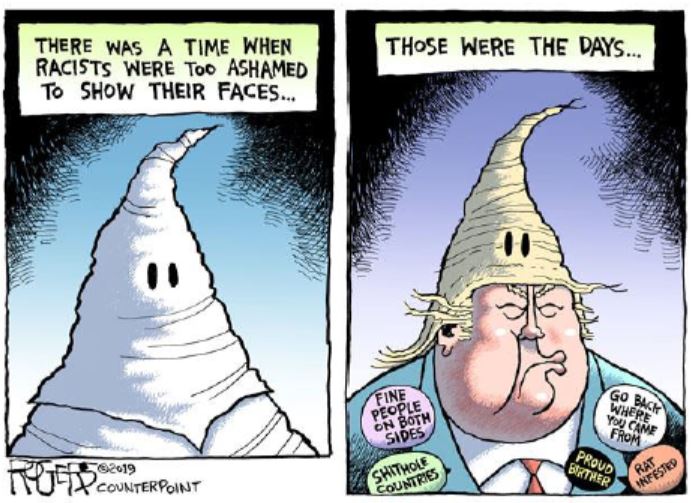
***
Mrs Linde Turner, Drumheller AB
30 July 2019
Mr Murray Klippenstein
Klippensteins, Barristers & Solicitors
160 John Street, Suite 300
Toronto ON M5V 2E5
Dear Mr Klippenstein:
I met you several times during the 12 years of your representation of Ms Jessica Ernst of Rosebud in Alberta. I am now wondering about your withdrawal from her case after so many years as her lawyer, and so many hundreds of thousands of dollars. Your notice of withdrawal was on 26 August 2018, but she informs me that it is at present incomplete in terms of accounting, documentation, and financial return of the trust account.
The trust account of $40,000 is a very significant amount of money, especially to Ms Ernst – who is no longer able to work in her profession.
I consulted the Law Society of Ontario’s Practice Management Guidelines for Client Service and Communication, Section 2.18 Withdrawal of Services, or Otherwise Ending the Engagement. There are many references to the Rules of Professional Conduct Section 3.7 which clearly describe the obligations of a lawyer. You do not appear to have followed most. Do you intend to do so in a timely fashion?
While you claim to have minimized your office staff, it appears the physical office still exists, and you have not given up your accreditation as a lawyer in Ontario. It would therefore appear that you have obligations of some urgency to fulfill for Ms Ernst.
Your prompt attention would be appreciated by many of us who have followed her case and her website.
Yours truly,
Linde Turner
CC The Law Society of Ontario
Ms Natasha Hassan, Opinion Editor, The Globe and Mail
Mr Ossie Sheddy, Editor, The Drumheller Mail
Mr Jacques Gallant, Legal Affairs Reporter, Toronto Star
Mr Andrew Nikiforuk, Investigative Journalist
Ms Jessica Ernst
vicky mochama @vmochama Jun 5
whenever someone says “casual racism”, i imagine an all-denim kkk hood
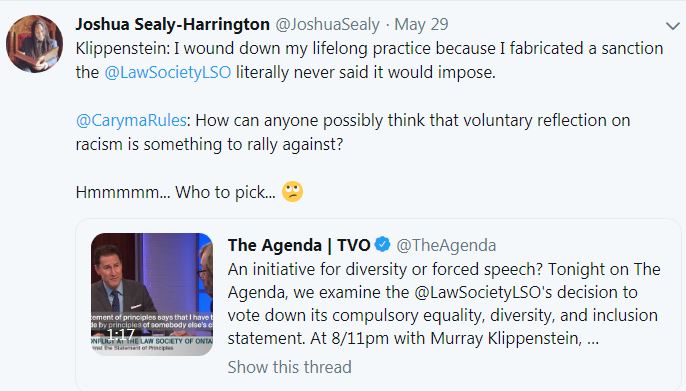
Shibil Siddiqi @ShibilSiddiqi May 30
As a lawyer I’m compelled to: swear an oath; refer to judges as “Your Honour”; bow to judges; refer to opposing counsel as “my friend”. The list goes on and on. But being compelled to confirm a professional obligation to human rights is where we draw the line?
Amelia Leckey @AmeliaLeckey May 29 Replying to @TheAgenda @LawSocietyLSO and 3 others
1) the content of a person’s statement was never prepared for them and does not even need to be made public 2) there is no way to disbarr someone for not preparing a statement.
And 3) his firm still has an active website and appears to be accepting applications for summer and articling positions.
Paul-Erik Veel @PaulErikVeel May 2 Paul-Erik Veel Retweeted Romac
Once #stopSOP shows me they also campaigned against our oath and annual reporting requirements to the Law Society, I will believe this is just about compelled speech.
We compel speech all the time for good reason. And in my books, diversity and inclusion is a damn good reason.
Joshua Sealy-Harrington @JoshuaSealy May 1
A democratic process has revealed that an astonishing number of lawyers think the most important issue facing the legal profession in 2019 is not [Access to Justice], but stopping an annual, private, and unscrutinized journal entry reflecting on equality. This is white supremacy. Name it.
lisa kerr @coleenlisa Apr 18 lisa kerr Retweeted Queen’s University
An apology for a ban on black students in the medical school that was enforced until 1965 (!!!)
David Gill @dtgill Apr 16 David Gill Retweeted StopSOP
“A society that has done something special against the Negro for hundreds of years must now do something special for the Negro.” -Martin Luther King, Jr.
StopSOP @Stop_SOP April 11
“In today’s world, Martin Luther King Jr. would be a racist.” @Willweargloves
Joshua Sealy-Harrington @JoshuaSealy Apr 15 Joshua Sealy-Harrington Retweeted StopSOP
1. No he would not.
2. You don’t understand MLK. Stop co-opting partial quotes to preserve the white supremacy he invested his life—literally—in dismantling.
3. Anti-racism ≠ colourblindness; Protesting racism is not protesting race-consciousness.
Joshua Sealy-Harrington @JoshuaSealy Apr 10 Joshua Sealy-Harrington Retweeted Fred Wu
I was:
-1 of 3 black law students in my year of law school
-The only black clerk at the Federal Court
-The only black lawyer in my 100+ law firm
–The only black clerk at the Supreme Court, two years running (a Court which has never had a black judge in history)
Joshua Sealy-Harrington @JoshuaSealy Apr 8 Joshua Sealy-Harrington Retweeted NCAA WBB
“People hire people who look like them, and that’s the problem.”
“Fit”, distilled.
***
2019 07 30: More brilliance (on twitter) by Joshua Sealy-Harrington @JoshuaSealy:

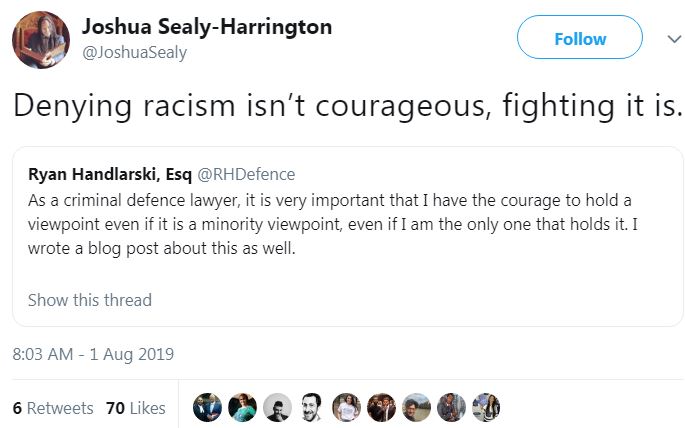
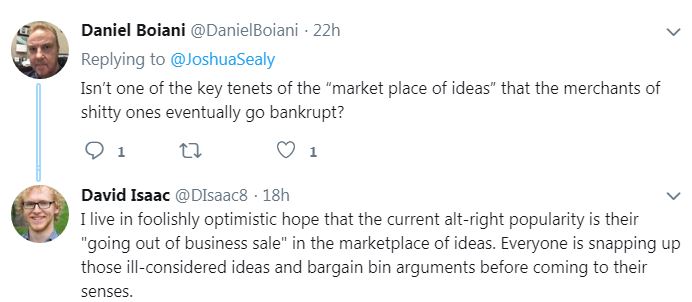
Aug 1
If racists can’t be named, racism can’t be shamed.
That’s why white supremacy invests so much effort in making racism unthinkable—to leave racists untouchable.
Jul 30
Thread on “fit”, and its overlap with race, despite RHDefence‘s recent post (https://rhcriminaldefence.com/leadership/bay-street-refugee-black-and-white-on-bay-street.html …). TL;DR: His entire argument is a strawman. He doesn’t disprove racial fit, he ignores it. And his examples, ironically, illustrate racial exclusion, rather than refuting it.
1. FRAMING: Ryan asks “if skin colour or race is a satisfying explanation for law students experiencing a lack of fit on Bay Street”? But no one claims that. Fit—like all issues implicating identity—is intersectional. Gender, race and class all impact fit; they make us different.
The above is a complete response to Ryan’s superficial analysis. He concludes that “many white people” don’t fit, too. But why is that? White *women* may not fit masculine norms; White *Mormons* may not fit religious norms; White *LGBT* people may not fit gender/sexuality norms.
These examples of white unfit don’t refute hadiyaroderique‘s fit thesis, they extrapolate on it in the context of other vectors of oppression. In other words, Ryan isn’t critiquing Hadiya’s argument, he’s making it.
2. EXAMPLES: Ryan’s lack of intersectional lens—his fundamental flaw—is illustrated in his examples. He discusses an awkward lunch with an etiquette coach. Given his thesis (that race doesn’t account for this kind of exclusion), he presupposes that etiquette is not racialized.
But this is plainly false. Etiquette is a social construct. What is polite, here, is different from what is polite elsewhere. People who are accustomed to the norms of etiquette followed at law firms will find it easier to fit in. And those norms are racialized.
Ryan also raises the example of firm golf and ski events. I’m not kidding, he raises GOLFING and SKIING in his argument, two of the most racialized and classed sports in Canada (polo, aside). People’s discomfort with these events is racialized. Ryan’s just not seeing that.
Ryan even says the prototypical student of fit is the one “who would be most likely to have joined a fraternity.” In other words, the stereotypical “All-Canadian” athletic bro. But that stereotype is white. “Animal House” didn’t win prizes for diverse casting.
And my favourite example: when Ryan says his experience of unfit “constantly felt like [he] was stuck in a @JordanPeele movie.” Buddy, rewatch “Get Out” and “Us”. They’re unequivocally about race, and went comically over your head.
3. RACE: Viewed this way, Ryan doesn’t succeed in extricating race from fit. He simply doesn’t understand the various ways race manifests. Racism isn’t just about how you look; It’s about logics of white supremacy. Those logics can exclude people who look, talk, or act different.
That Ryan speculates about all the other white students being equally uncomfortable is unconvincing. Again, intersectionality. Were they poor? Immigrants? Did they have social anxiety? Because, in my experience, dominant groups navigate legal spaces with much greater ease.
And I say this as someone who benefitted from that dominance. I found legal practice much easier as a man because of masculine norms. Clients often value masculinity, as do partners. Sometimes I felt like I fit, but that doesn’t de-racialize fit, it merely complicates it.
Ryan inadvertently concedes this. He discusses how the elite skiers fit in better. In his words, they could display “status”. But that status—being good at skiing—intersects with race and class. Rich white people ski more and they take their kids skiing, too. This is racial fit.
So, when Ryan rhetorically asks “What percentage of people of any race could possibly enjoy” “ski competitions where people show off their status … and incessant and insipid conversations about golf?” he defeats his point. More rich white people will enjoy that, Ryan—that’s fit
Does race explain everything? No. No one claims that. Ryan says a rich non-white person may fare better than a poor white person. Fine. That just shows that race *and* class are vectors of fit; however, it does not disprove race’s independent role in fit.
4. SPECTRUM: Ryan’s argument contains another sleight of hand. He says that “every group feels uncomfortable at a Bay Street law firm.” Sure. Perhaps on the discomfort binary no one is thrilled. But fit is a spectrum. And Hadiya’s point remains that race informs that spectrum.
Indeed, if “every group” felt equally uncomfortable, why is it that, as we climb the Bay Street hierarchy, firms get more white, and more masculine. Either white men are innately better lawyers (lol), or something else is happening. That something else is fit.
I know how some will respond. They’ll cite “exceptions”. Some Black people ski; some Black people golf (Tiger Tiger Tiger Woods y’all); and some Black people join frats. This is a distraction. Racial logic is difficult to detect precisely because it operates on a spectrum.
And Ryan concedes this, unwittingly. He says that things like “immigrant” status and “not sharing common interests” inform fit. His argument is predicated on race bearing no relation to these factors, but of course it does.
5. CREDIBILITY: Ryan assumes he knows best. He “feels[s] very confident in saying that no one struggled more than [he] did” (lol). But he also says racialized lawyers “are much more likely to ascribe [unfit] to their race.” These are actual quotes.
Let’s translate this: Ryan is “very confident” *no one* struggled more than him, while racialized lawyers “imagine” racial barriers. I’m sorry, but no. Ryan is not the arbiter of racial dynamics in law firms. And, as noted, the contexts of exclusion he describes are racialized.
In sum, Ryan’s argument is (1) race has no relationship to everything that makes us an individual; (2) fit is based on who we are as individuals; thus (3) race has no impact on fit. His key mistake is (1), which he makes throughout his argument.
Of course, none of this critique is necessary. Ryan ultimately concedes that “the vast majority of the people groomed for [fit] are white, went to private schools, took ski and golf lessons, play hockey and have a cottage.” That’s literally the fit critique, distilled.
Fit reflects power, which race and class inform. This was Hadiya’s modest point, and Ryan concedes it. His piece refutes nothing, except itself. The only thing he shows is how ill-informed he is on the complex and subtle ways that racial exclusion manifests in society.
A few tweets in response:
Greg Allen @gregjlallen Jul 30 Replying to @JoshuaSealy @RHDefence
You are literally one of the handful of reasons I don’t delete Twitter. Thanks for this
Omar Ha-Redeye @OmarHaRedeye Jul 30 Replying to @JoshuaSealy @RHDefence
The fact you took the time to do this makes you a hero.
Pretty sure he won’t respond. I wouldn’t know if he did though, because he mass blocks racialized lawyers.
I’m blocked! Yippie! Are you?

Omar Ha-Redeye @OmarHaRedeye Jul 30
Will there be a second stopSOP? Or just a soft version?
Evan VanDyk @EVanDyk Jul 31
He has a blog article on the SOP where he says he doesn’t see race and cites Ayn Rand.
Andrew Lee @Andrewmklee Jul 31 Replying to @JoshuaSealy @RHDefence
One of the best threads I’ve read in a long time. Very similar parallels can be drawn in medicine!!!
Clinton Mikhow @ClintonMikhow Aug 2, 2019 Replying to @JoshuaSealy @RHDefence
This whole thread is wonderful. I was considering responding but you did a hell of a job, nothing else need be said.
Immanuel@paradoxifl Jul 30 Replying to @JoshuaSealy @RHDefence
don’t even waste your energy on this loser. ain’t nobody reading his shit. ms roderique on the other hand blew the lid off this whole profession and their hypocrisy.
Emmett Macfarlane @EmmMacfarlane Aug 1 More Emmett Macfarlane Retweeted Joshua Sealy-Harrington
Superb thread, not only on the specific issues addressed, but for anyone who doesn’t understand how racial barriers exist in societal & structural ways, not just as a product of explicitly racist acts or decisions. Also, @JoshuaSealy is a must-follow.
Rick Frank @_RickFrank Aug 1 Rick Frank Retweeted Joshua Sealy-Harrington
If you’re not following @JoshuaSealy, what are you doing?
***
Racism Comes Out of the Closet, The dog whistle days are apparently over by Paul Krugman, July 15, 2019, New York Times
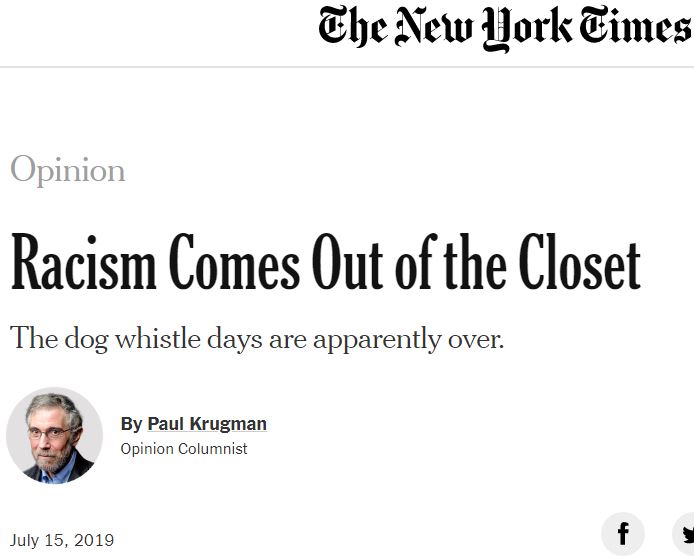
Paul Krugman has been an Opinion columnist since 2000 and is also a Distinguished Professor at the City University of New York Graduate Center. He won the 2008 Nobel Memorial Prize in Economic Sciences for his work on international trade and economic geography.
In 1981 Lee Atwater, the famed Republican political operative, explained to an interviewer how his party had learned to exploit racial antagonism using dog whistles. “You start out in 1954 by saying ‘Nigger, nigger, nigger.’” But by the late 1960s, “that hurts you, backfires. So you say stuff like, uh, ‘forced busing,’ ‘states’ rights,’ and all that stuff, and you’re getting so abstract. Now, you’re talking about cutting taxes, and all these things you’re talking about are totally economic things and a byproduct of them is, blacks get hurt worse than whites.”
Well, the dog whistle days are over. Republicans are pretty much back to saying “Nigger, nigger, nigger.” …
This should be a moment of truth for anyone who describes Trump as a “populist” or asserts that his support is based on “economic anxiety.” He’s not a populist, he’s a white supremacist. His support rests not on economic anxiety, but on racism.
… First, this isn’t just about Trump; it’s about his whole party.
I don’t just mean the almost complete absence of condemnation of Trump’s racism on the part of prominent Republicans, although this cowardice was utterly predictable. I mean that Trump isn’t alone in deciding that this is a good time to bring raw racism out of the closet. [Happening in Canada too! Law Society of Ontario’s StopSOP vs SOP conflict and the ever growing bolder racism in Alberta a few shameful examples]
Last week Bill Lee, the Republican governor of Tennessee, signed a proclamation ordering a day to honor the Confederate general Nathan Bedford Forrest, whom he described as a “recognized military figure.” Indeed, Forrest was a talented military commander. He was also a traitor, a war criminal who massacred African-American prisoners, and a terrorist who helped found the Ku Klux Klan. …
Second, although most of the commentary focuses on Trump’s demand that native-born Americans “go back” to their home countries, his description of their imaginary homelands as “crime infested” deserves some attention, too. For his fixation on crime is another manifestation of his racism.
I’m not sure how many people remember Trump’s inaugural address, which was all about “American carnage” — an alleged epidemic of violent crime sweeping our nation’s cities. He didn’t explicitly say, but clearly implied, that this supposed crime wave was being perpetrated by people with dark skins. And, of course, both Trump and the Trumpist media go on all the time about immigrant criminality.
In reality, violent crime in America’s big cities is near historical lows, and all the available evidence suggests that immigrants are, if anything, less likely than the native-born to commit crimes. But the association between nonwhites and crime is a deeply held tenet among white racists, and no amount of evidence will shake their belief. …

The Nation’s Top State Courts Face a Crisis of Legitimacy, Judges on state supreme courts don’t reflect the diversity of their communities [Same in Canada?] by Alicia Bannon and Laila Robbins, July 23, 2019, New York Times
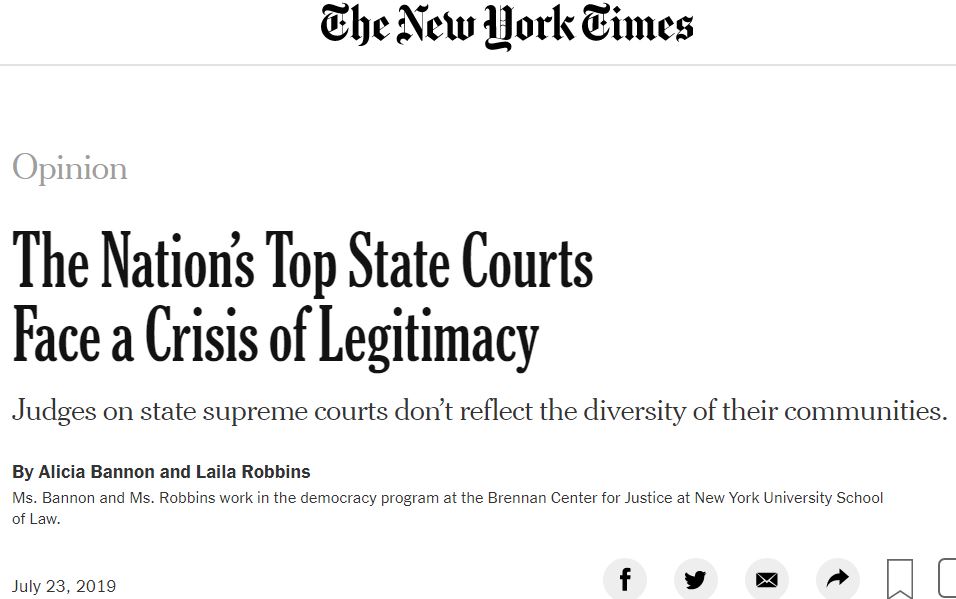
Ms. Bannon and Ms. Robbins work in the democracy program at the Brennan Center for Justice at New York University School of Law.
The nation’s courts have a checkered history when it comes to doling out justice for people of color and women. We often focus on the egregious outcomes — racial disparities in sentencing, over-incarceration of black men, courts that ignore survivors of sexual violence. Less often do we consider which factors might contribute to these injustices, including the race and gender of the justices who sit on the top state courts.
We reviewed 60 years of data and found that those who preside over these often overlooked but powerful institutions continue to be overwhelmingly white and male. This lack of diversity creates a legitimacy crisis for the justice system.
While national attention is often focused on the United States Supreme Court, the top courts in each state typically are the final word on interpreting state law and making decisions that more thaled in the United States are heard in state courts.
Those courts decide some of the most pressing issues affecting our lives. In recent years, state supreme courts have reversed billion-dollar verdicts in consumer protection cases, authorized executions using experimental drugs, barred localities from regulating fracking and struck down restrictive abortion laws.
But seldom do these courts look anything like an increasingly diverse America.
We found that nearly half of all states do not have a single justice sitting on their high courts who is black, Asian, Latino, or Native American — even though people of color make up about 40 percent of the population. In eight of the 24 states with all-white high courts, people of color make up at least a quarter of the population. Thirteen states have not seated a single justice of color since at least 1960. Eighteen states have never seated a black justice. [Frac! That’s scary and ugly.]
The dearth of gender diversity is also appalling. Women hold only 36 percent of the seats on top state courts. Seventeen states have only one female justice. (State supreme court benches have five to nine justices.)
We also found that not only are state high court judges overwhelmingly homogeneous, but also, by some measures, state courts are becoming less reflective of the nation’s diversity than they were a generation ago. While there are more lawyers of color than ever before, we found that the gap between the proportion of people of color on the bench and their representation in the American population was higher in 2017 than it was in 1996.
The public legitimacy of our entire judicial system is under threat if the judges making crucial decisions about the law don’t reflect the diversity of the communities affected. As former Justice Yvette McGee Brown of the Ohio Supreme Court observed, the public’s perception of justice suffers “when the only people of color in a courthouse are in handcuffs.”
What’s more, research has shown that diversity on the bench enriches judicial deliberations.
Studies of federal courts found that when a female justice or a justice of color sits on a panel, their male or white colleagues are more likely to side with plaintiffs in civil rights cases.
The lack of racial and gender diversity on the bench is driven by a host of factors — including the underrepresentation of women and people of color in leadership positions within the law, implicit and explicit biases, and low judicial salaries that can make it difficult to attract top candidates. These are areas that deserve further study. …
Denying Racism Supports It, Refusing to address and acknowledge the prejudices in our country is a big part of the problem by Charles M. Blow, July 21, 2019, New York Times
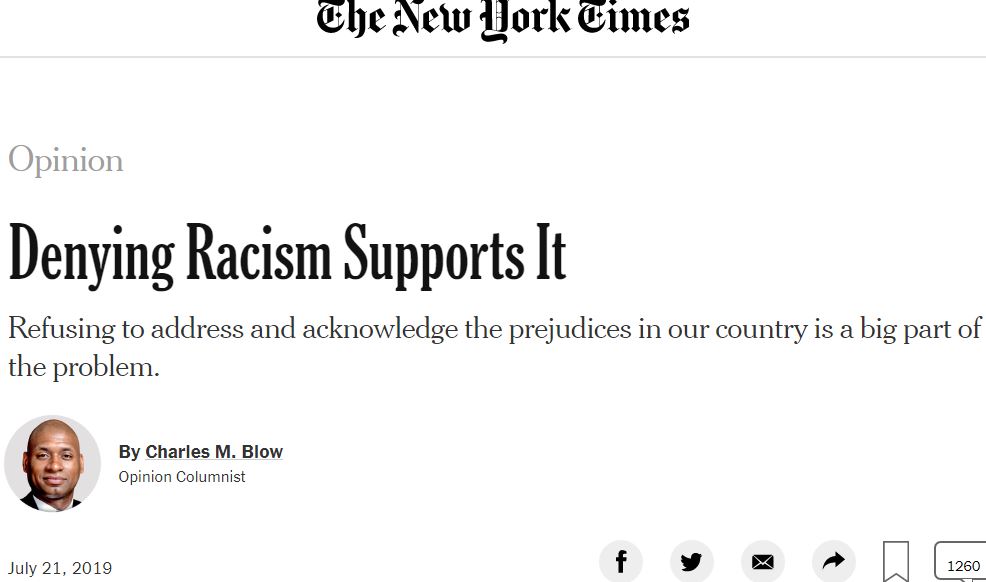
Charles Blow joined The Times in 1994 and became an Opinion columnist in 2008. He is also a television commentator and writes often about politics, social justice and vulnerable communities.
When did we arrive at the point where applying the words racist and racism was more radioactive than actually doing and saying racist things and demonstrating oneself to be a racist?
How is it that America insists on knowledge of the unknowable — what lurks in the heart — in order to assign the appellation?
Why are so many Americans insisting that racism requires conscious, malicious intent in order for the title to be earned?
Last week, much of America wrestled with whether to label the president racist after he published racist tweets about four congresswomen of color, demonstrating once again in the most overt terms that he is indeed a racist.
And yet many, including those in the media, struggled with whether or not to label his tweet, and by extension Donald Trump himself, as racist.
As the Columbia Journalism Review put it, some outlets did label the tweets as racist, but “On the whole, however, the news desks of mainstream news organizations did not call the tweets racist, or at least did not do so consistently across their output.”
In many cases it was up to critics, pundits and columnists to be the loudest voices in the chorus willing to call a thing a thing. And many of those voices were people of color who have been properly labeling Trump what he is from the beginning.
But, this raises a very serious question, particularly for our white colleagues in journalism and our fellow white citizens: What took you so long? Were these tweets really your racial Rubicon? Or, were they simply your last straw? Did nothing else in his decades-long track record earn him the designation? Or, do you simply reset the racism dial every few months?
It seems to me that white journalists in particular — and white citizens, in general — have done a tremendous injury to truth and honesty by providing the dangerous illusion that racism was hard to define and racists were hard to designate.
This newspaper is not exempt from that critique.
And specifically, by leaving people of color out on a limb as the primary voices of truth on these racial issues, you have created the impression that the use of these terms is born of personal grievance rather than professional assessment.
By refusing to add your white voices you gave the defining of racism a black face. You allowed people to believe that the telling of truth and bearing of witness by some, we black and brown few, has the appearance of being corrupted and compromised by ignoble motive.
A USA Today/Ipsos poll published on July 17 found that more than twice as many Americans believe that people who call others racist do so “in bad faith,” compared with those who do not believe it.
This all contributes to whittling away at the reality of racism itself, that it even exists in nearly the proportions which social scientists have documented. This refusal to properly and consistently call racism racism allows the pro-racists and the racism deniers to proclaim nearly unopposed that labeling something or someone racist has simply become a weapon, and that the words themselves have lost meaning by overuse.
In truth, the opposite is true: Racism is actually under-identified and labeled in America.
And, I believe that too many of our white neighbors are choosing to be intentionally blind to the enormous breadth and scope of racism in this country, because to acknowledge it would be to condemn self, family, friends and community. It would be to recognize that much of their existence is privileged, and conversely blackness is oppressed.
Shirley Chisholm, the first African-American woman elected to Congress and the first to seek a major party nomination for president, once put it: “Racism is so universal in this country, so widespread and deep-seated, that it is invisible because it is so normal.”
There is racial bias embedded in nearly every aspect of America life: financial, medical, judicial, political, nutritional, environmental, educational, you name it.
Racism in America is like air — all around us, being constantly inhaled and exhaled, and if you are white, proving very beneficial to your health and survival.
It is precisely for that reason that many white people are incredulous when they see a person of color heaving, gasping for breath, complaining that the air is poisoned.
How is it that this invisible thing that sustains me simultaneously causes you grievous injury?
And so begins the mental gymnastics to assign another cause, to accuse the asphyxiated of histrionics.
Make no mistake: Denying racism or refusing to call it out is also racist.
You cannot claim to be egalitarian and anti-racism and choose to be closeted among family and friends or even in your community for fear of rejection and ostracism, or as is often used as an excuse, to keep the peace.
There is no peace for the targets of racism, so your choosing of personal comfort and the comfort of racists supports the commission of racial injury.
If you are just coming to call Trump’s behavior racist — or, worse yet, if you still can’t bring yourself to do so — you are part of the problem. You are supporting that architecture of white racism.
An excellent comment to Mr. Blow’s piece:
Tony Glover, New York, July 22
Times Pick
There is such bravery in Mr. Blow’s words. He may deny any such bravery, but with all the blowback he will get, I wanted to say thank you to him for writing such unvarnished clarity.
I am African American, Mr. Blow, and I cannott tell you how emotional I got reading this. It made me feel present and acknowledged in a way I have not in a very long time reading a mainstream publication. Thank you.
Indeed, the tears flowed as I read this, but it also re-energized me to read these words.
It is such a simple thing to acknowledge another’s pain, and yet so many people cannot do that. That acknowledging my pain should implicate white people brought a clarity to what might, at times, informs their hesitation.
Mostly though, your words brought home with such gravitas that when someones denies racism exists, they deny my existence, my reality.
I don’t want to relieve the disappearance of my life over and over again in mainstream media or in reader comments.
It exacts a toll of which I may not always be aware.
Today, I am most thankful for the balm your writing offers.
FunkyIrishman member of the resistance July 22
Times Pick
First they came for the ”fill in the blank” & nobody cared.
Indeed, when something is so systematic and ingrained, then one is conditioned not to question. However, when one sees human rights, or even just dignity being upheld (against all odds even), then one can never go back. (if they have a decent core)
This is why we are in the last throws of a vicious white privilege backlash at all levels. Demographics are slowly marching on regardless of what the people that want to go back to the 50’s (1850’s) try to do.
We have had our first African American President. We have a sizable portion of Congress that is now made up of women and of color. We have major candidates of color and women, again running for President. (with very good odds mind you)
All is not well, but the point is that young kids now have many more role models than they ever did. So couple that with (again) demographics and there is the collective anxiety of white people wanting to draw up some fictional drawbridge.
Voting again for this administration is tantamount to supporting the ideas put forth in this column. Staying home is very much the same.
We can no longer remain silent.
***
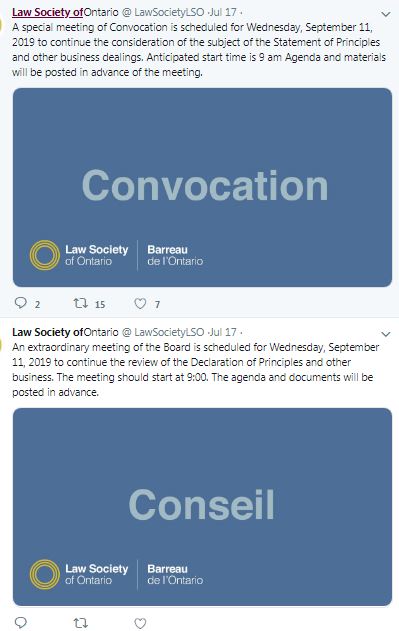
Law Society of Ontario tweets above snapped from:
https://twitter.com/lawsocietylso?lang=en
A bit of SOP background:
Tweet by David Isaac @DIsaac8 Jun 29
… The SOP was created after 4 years of research which found that lack of diversity and inclusion was a serious problem facing the profession.
The SCC has recently affirmed the importance of diversity and inclusion to the profession.
The SOP was a way for lawyers to think about how they could solve this problem in their own practices.
As for the reference to “virtue signalling,” that term is an alt-right smear which is used to diminish any attempts to promote diversity and inclusion by implying that those promoting such ideals don’t actually hold them but merely want to appear virtuous.
I very much doubt that the extensive research and consultations done in the past by the LSO and the work that so many people have done to promote diversity and inclusion in the profession was done simply because they wanted to appear virtuous.
Given the vacillation of Stop SOP in past few days I don’t think they are in a position to make allegations that pro SOP folks are somehow unprincipled. Regardless, it is very disappointing to see a Bencher use the language of the alt-right.
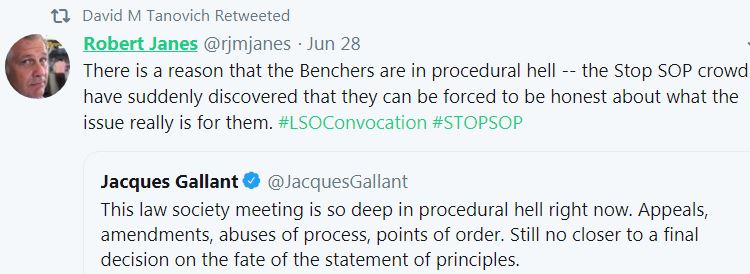
Robert Janes @rjmjanes Jun 28
The so called principled debate that was being led by them against “compelled” speech was suddenly confronted with “well let’s make it a voluntary statement of aspiration.” No more compulsion! #LSOConvocation #STOPSOP
Now suddenly the anti-SOP-er’s have to make a real statement of principles — is the issue the compulsion or the aspiration to promote diversity and inclusion? Unfortunately for the convocation it turns out that a lot of them are not just opposed to the compulsion.
It now seems that they also have problems with the aspiration to make the profession more diverse and inclusive. So how do they deal with that? Create their own procedural roadblocks to having a debate about the aspiration without compulsion? #LSOConvocation
Refer also to:
How prevalent is racism (and misogyny) among Canadian lawyers & judges?
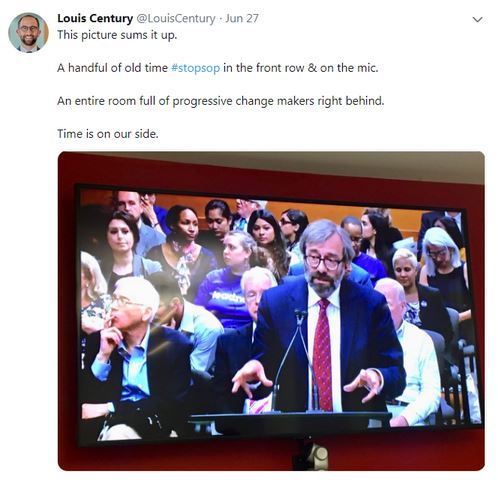
Stop endless debate on SOP at law society Convocation
… Convocation is a quasi-legislative body, which has its own mechanisms for sober second thought intrinsic to its own constitution.
The process of judicial review and challenges through the court are protracted and costly. Those expenses ultimately come from our legal fees.
An ineffective debate at Convocation therefore, despite being less than desirable, is still a better option than the alternatives.
Thousands of lawyers across Ontario have called on the law society to engage in further consultation, to deliberate and carefully reflect and only then make careful proposals about how to best move forward on the Statement of Principles issue. This work is best done in committee, over an extensive period of time and then brought back to Convocation.
Those calls should be heeded by all members of Convocation, including the StopSOP benchers. It is their fiduciary duty to do so.
Otherwise, we can likely expect more of the same in July, with even less accomplished.
There is nobody who observed Convocation on June 27 who would be able to credibly justify any of that in the public interest.
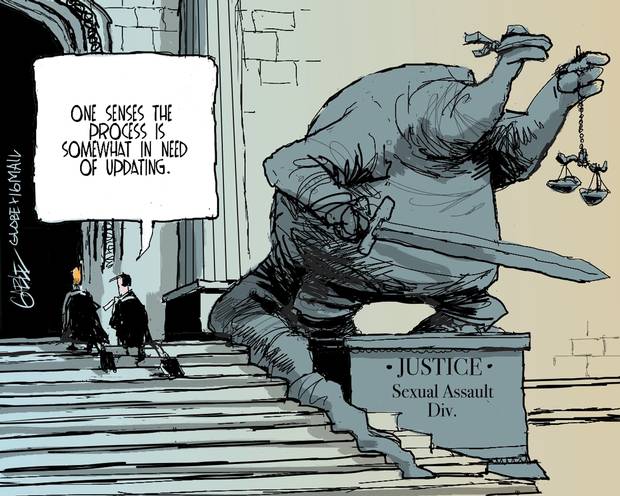
Enabling sexual predators? Enabling Canadian judges revictimizing sexual assault victims? Enabling Canada’s demented abusive legal system? Threatening sexual assault victims to keep silent? Galling, throw-women-back-into-the-cave statements by Canada’s Chief Justice Beverley McLachlin
Ontario Bar Association reaffirms commitment to promoting equity, diversity & inclusion, “speaks as a united voice.” Compare to Law Society of Ontario’s white supremacists squabbling childishly trying to hold onto power. How does a litigant get fair legal representation with shit like this going on?
“The [legal] system’s not broken; the system was built this way.” Of course it was! Just like it was built to piss on the poor, women, the environment and the Rule of Law itself
Attorney General of Canada “Breaks rules in Court. All. The. Time.” Fails to File Statement of Defence within 30 days. In Ernst vs Encana, Encana filed Statement of Defence more than 2 years late; Alberta Environment more than 3 years late
Canadian Lawyer: The profession’s dirty little secret
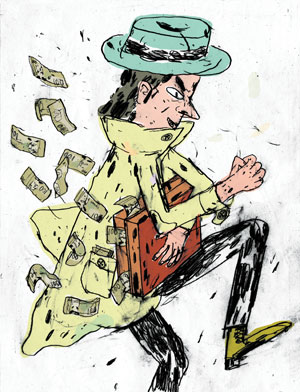
Illustration: Peter Mitchell
… David Debenham, a partner with McMillan LLP in Ottawa who is a certified fraud specialist and investigator, estimates only one in 10 frauds within the profession come to light. “A lot of firms that had lawyers, or law clerks, or staff that commit fraud tend to indemnify clients and not report it — it’s sort of the [profession’s] dirty little secret,” says Debenham, who is also a certified management accountant often hired by law firms to conduct fraud probes. He says there is no doubt the number of misappropriation cases is growing exponentially.
